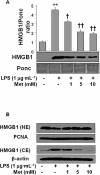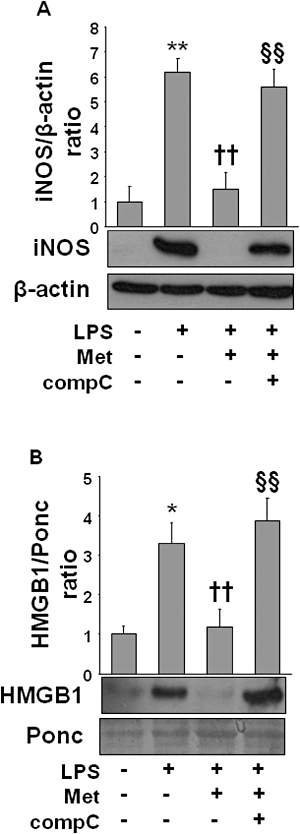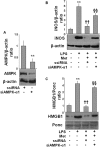Metformin inhibits HMGB1 release in LPS-treated RAW 264.7 cells and increases survival rate of endotoxaemic mice
- PMID: 21091653
- PMCID: PMC3057288
- DOI: 10.1111/j.1476-5381.2010.01126.x
Metformin inhibits HMGB1 release in LPS-treated RAW 264.7 cells and increases survival rate of endotoxaemic mice
Abstract
Background and purpose: Recently, metformin, a well-known anti-diabetic drug, has been shown to possess anti-inflammatory activities. This study investigated the effect of metformin on the expression of pro-inflammatory cytokines including high mobility group box 1 (HMGB1) in lipopolysaccharide (LPS)-treated animals and cells.
Experimental approach: We investigated whether metformin inhibits the release of HMGB1 in LPS-treated RAW 264.7 cells and increases survival rate in endotoxaemic mice (lethal endotoxaemia was induced by an i.p. injection of LPS). This was achieved by a range of techniques including Western blotting, enzyme-linked immunosorbent assay, specific pharmacological inhibitors, knock out of α(1) -subunit of AMP-activated protein kinase (AMPK) and recombinant HMGB1.
Key results: Both pre- and post-treatment with metformin significantly improved survival of animals during lethal endotoxaemia (survival rate was monitored up to 2 weeks), decreased serum levels of tumour necrosis factor-alpha (TNF-α), interleukin-1β, HMGB1 expression and myeloperoxidase activity in lungs. However, metformin failed to improve survival in endotoxaemic animals that had additionally been treated with recombinant HMGB1. In an in vitro study, metformin dose-dependently inhibited production of pro-inflammatory cytokines and HMGB1 release. Metformin activated AMPK by its phosphorylation. Compound C (pharmacological inhibitor of AMPK) and siAMPKα1 reversed the anti-inflammatory effect of metformin in LPS-treated cells.
Conclusions and implications: Our data indicate that metformin significantly attenuates the pro-inflammatory response induced by LPS both in vivo and in vitro. Metformin improved survival in a mouse model of lethal endotoxaemia by inhibiting HMGB1 release. AMPK activation was implicated as one of the mechanisms contributing to this inhibition of HMGB1 secretion.
© 2011 The Authors. British Journal of Pharmacology © 2011 The British Pharmacological Society.
Figures








Similar articles
-
Mechanistic insights into dimethyl cardamonin-mediated pharmacological effects: A double control of the AMPK-HMGB1 signaling axis.Life Sci. 2020 Dec 15;263:118601. doi: 10.1016/j.lfs.2020.118601. Epub 2020 Oct 18. Life Sci. 2020. PMID: 33086122 Free PMC article. Review.
-
Escin Increases the Survival Rate of LPS-Induced Septic Mice Through Inhibition of HMGB1 Release from Macrophages.Cell Physiol Biochem. 2015;36(4):1577-86. doi: 10.1159/000430320. Cell Physiol Biochem. 2015. PMID: 26159678
-
A Dalbergia odorifera extract improves the survival of endotoxemia model mice by inhibiting HMGB1 release.BMC Complement Altern Med. 2017 Apr 12;17(1):212. doi: 10.1186/s12906-017-1725-0. BMC Complement Altern Med. 2017. PMID: 28403838 Free PMC article.
-
PACAP inhibit the release and cytokine activity of HMGB1 and improve the survival during lethal endotoxemia.Int Immunopharmacol. 2008 Dec 10;8(12):1646-51. doi: 10.1016/j.intimp.2008.07.014. Epub 2008 Aug 17. Int Immunopharmacol. 2008. PMID: 18713653
-
The expression of HMGB1 on microparticles released during cell activation and cell death in vitro and in vivo.Mol Med. 2014 Apr 1;20(1):158-63. doi: 10.2119/molmed.2014.00014. Mol Med. 2014. PMID: 24618884 Free PMC article. Review.
Cited by
-
Metformin Attenuates Brain Injury by Inhibiting Inflammation and Regulating Tight Junction Proteins in Septic Rats.Cell J. 2020 Jul;22(Suppl 1):29-37. doi: 10.22074/cellj.2020.7046. Epub 2020 Jul 18. Cell J. 2020. PMID: 32779431 Free PMC article.
-
Bet on NETs! Or on How to Translate Basic Science into Clinical Practice.Front Immunol. 2016 Oct 14;7:417. doi: 10.3389/fimmu.2016.00417. eCollection 2016. Front Immunol. 2016. PMID: 27790216 Free PMC article. No abstract available.
-
The Role of HMGB1 in the Pathogenesis of Type 2 Diabetes.J Diabetes Res. 2016;2016:2543268. doi: 10.1155/2016/2543268. Epub 2016 Dec 22. J Diabetes Res. 2016. PMID: 28101517 Free PMC article. Review.
-
Activation of AMP-activated protein kinase during sepsis/inflammation improves survival by preserving cellular metabolic fitness.FASEB J. 2020 May;34(5):7036-7057. doi: 10.1096/fj.201901900R. Epub 2020 Apr 4. FASEB J. 2020. PMID: 32246808 Free PMC article.
-
Mechanistic insights into dimethyl cardamonin-mediated pharmacological effects: A double control of the AMPK-HMGB1 signaling axis.Life Sci. 2020 Dec 15;263:118601. doi: 10.1016/j.lfs.2020.118601. Epub 2020 Oct 18. Life Sci. 2020. PMID: 33086122 Free PMC article. Review.
References
-
- Abdulahad DA, Westra J, Limburg PC, Kallenberg CG, Bijl M. HMGB1 in Systemic Lupus Erythematosus: its role in cutaneous lesions development. Autoimmun Rev. 2010;9:661–665. [Epub ahead of print] - PubMed
-
- Andersson U, Harris HE. The role of HMGB1 in the pathogenesis of rheumatic disease. Biochim Biophys Acta. 2010;1799:141–148. - PubMed
-
- Bailey CJ, Turner RC. Metformin. N Engl J Med. 1996;334:574–579. - PubMed
-
- Bergheim I, Luyendyk JP, Steele C, Russell GK, Guo L, Roth RA, et al. Metformin prevents endotoxin-induced liver injury after partial hepatectomy. J Pharmacol Exp Ther. 2006;316:1053–1061. - PubMed
Publication types
MeSH terms
Substances
Grants and funding
LinkOut - more resources
Full Text Sources
Research Materials

